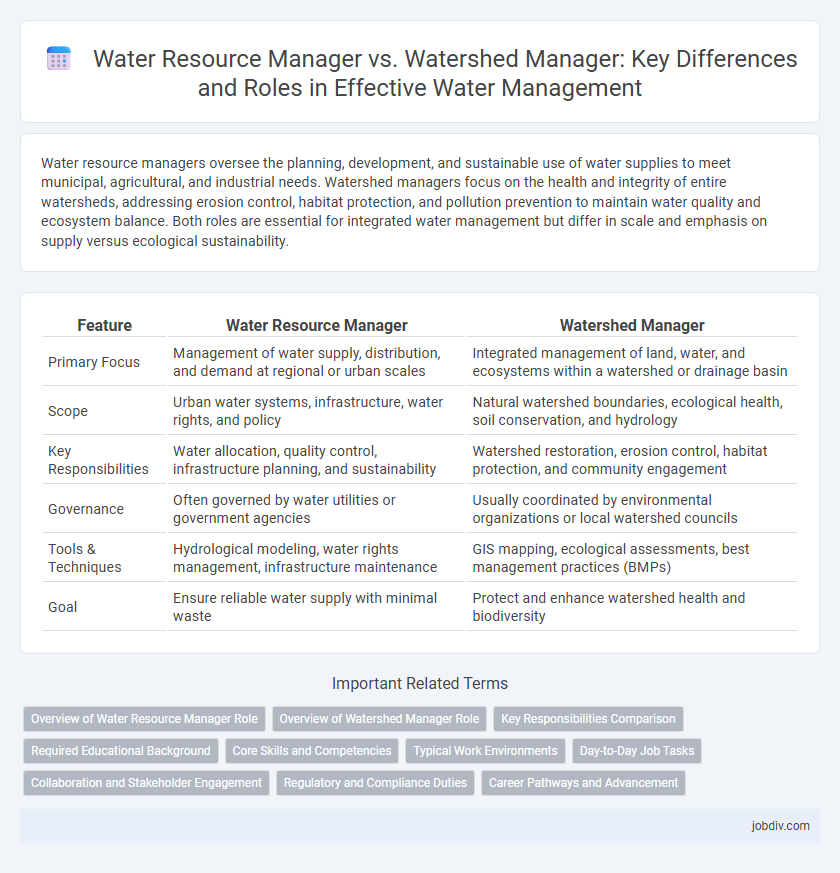Water resource managers oversee the planning, development, and sustainable use of water supplies to meet municipal, agricultural, and industrial needs. Watershed managers focus on the health and integrity of entire watersheds, addressing erosion control, habitat protection, and pollution prevention to maintain water quality and ecosystem balance. Both roles are essential for integrated water management but differ in scale and emphasis on supply versus ecological sustainability.
Table of Comparison
| Feature | Water Resource Manager | Watershed Manager |
|---|---|---|
| Primary Focus | Management of water supply, distribution, and demand at regional or urban scales | Integrated management of land, water, and ecosystems within a watershed or drainage basin |
| Scope | Urban water systems, infrastructure, water rights, and policy | Natural watershed boundaries, ecological health, soil conservation, and hydrology |
| Key Responsibilities | Water allocation, quality control, infrastructure planning, and sustainability | Watershed restoration, erosion control, habitat protection, and community engagement |
| Governance | Often governed by water utilities or government agencies | Usually coordinated by environmental organizations or local watershed councils |
| Tools & Techniques | Hydrological modeling, water rights management, infrastructure maintenance | GIS mapping, ecological assessments, best management practices (BMPs) |
| Goal | Ensure reliable water supply with minimal waste | Protect and enhance watershed health and biodiversity |
Overview of Water Resource Manager Role
Water Resource Managers oversee the sustainable allocation, development, and management of water supplies to meet agricultural, industrial, and domestic needs. Their role involves analyzing hydrological data, ensuring regulatory compliance, and coordinating with stakeholders to optimize water distribution and quality. This position requires expertise in water policy, infrastructure management, and environmental impact assessment to balance resource use and conservation.
Overview of Watershed Manager Role
A Watershed Manager specializes in overseeing the health and sustainability of watershed ecosystems by monitoring water quality, managing land use within the watershed, and coordinating conservation efforts. This role involves collaborating with local communities, regulatory agencies, and environmental organizations to implement strategies that protect water resources and reduce pollution. Their primary goal is to balance ecological preservation with human activities, ensuring long-term water availability and ecosystem resilience within the watershed.
Key Responsibilities Comparison
Water Resource Managers focus on the sustainable allocation, regulation, and quality control of water supplies across regions, ensuring compliance with environmental laws and addressing demands from agriculture, industry, and urban areas. Watershed Managers concentrate on maintaining and restoring the health of specific watershed ecosystems by managing land use, erosion control, and habitat preservation to support water quality and biodiversity. Both roles require collaboration with stakeholders and the implementation of monitoring systems but differ in scale, with Water Resource Managers operating at broader hydrological system levels and Watershed Managers targeting localized catchment areas.
Required Educational Background
Water Resource Managers typically require a bachelor's degree in environmental science, civil engineering, or hydrology, emphasizing technical skills in water distribution and treatment systems. Watershed Managers often hold degrees in ecology, environmental management, or natural resource management, focusing on ecosystem health, soil conservation, and land-use planning. Both roles benefit from specialized training in GIS, water quality analysis, and environmental policy to effectively manage water resources and watershed sustainability.
Core Skills and Competencies
Water Resource Managers excel in hydraulic modeling, water quality analysis, and regulatory compliance, ensuring sustainable allocation and usage of water supplies. Watershed Managers specialize in land-use planning, ecosystem restoration, and stormwater management to protect and enhance watershed health and biodiversity. Both roles require strong skills in GIS mapping, data analysis, and stakeholder collaboration to effectively manage water systems and environmental impacts.
Typical Work Environments
Water Resource Managers typically work in government agencies, environmental consulting firms, and utility companies, focusing on managing water supply systems, quality control, and regulatory compliance. Watershed Managers are often employed by conservation organizations, environmental nonprofits, and natural resource departments, where they oversee land use, habitat restoration, and stormwater management within specific watershed areas. Both roles frequently operate in field settings, coordinating with stakeholders to implement sustainable water management practices.
Day-to-Day Job Tasks
Water Resource Managers oversee the planning, development, and sustainable use of water supplies to ensure quality and availability for various needs such as agriculture, industry, and municipal use. Watershed Managers focus on maintaining and restoring watershed health through monitoring water flow, controlling erosion, and implementing conservation practices within a specific drainage basin. Daily tasks for Water Resource Managers involve data analysis, regulatory compliance, and infrastructure planning, while Watershed Managers engage in field assessments, community outreach, and habitat restoration projects.
Collaboration and Stakeholder Engagement
Water Resource Managers coordinate with multiple agencies to allocate water efficiently, prioritizing sustainable use across urban and agricultural sectors. Watershed Managers engage local communities and environmental groups to restore and maintain ecosystem health within specific drainage basins. Collaboration between these managers enhances integrated water governance by aligning resource distribution with watershed conservation efforts.
Regulatory and Compliance Duties
Water resource managers oversee the sustainable allocation and quality control of water supplies, ensuring compliance with federal and state regulations such as the Clean Water Act and Safe Drinking Water Act. Watershed managers focus on maintaining watershed health by implementing land use policies and coordinating with environmental agencies to meet regulatory standards for water quality and habitat protection. Both roles require detailed reporting, permits management, and adherence to environmental regulations that govern water use, pollution control, and conservation efforts.
Career Pathways and Advancement
Water Resource Managers oversee the planning, development, and sustainable management of water supplies, often advancing into roles such as Environmental Director or Hydrology Consultant by gaining expertise in water policy and infrastructure projects. Watershed Managers specialize in managing and restoring watershed ecosystems to maintain water quality and biodiversity, with career progression toward roles like Ecological Restoration Specialist or Conservation Program Manager through gaining skills in GIS and ecosystem assessment. Both paths offer advancement opportunities in environmental agencies, consulting firms, and governmental organizations focused on water sustainability and climate resilience.
Water Resource Manager vs Watershed Manager Infographic

 jobdiv.com
jobdiv.com